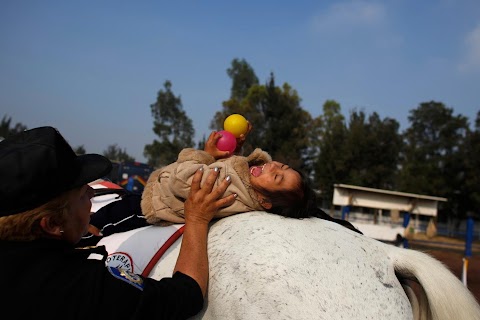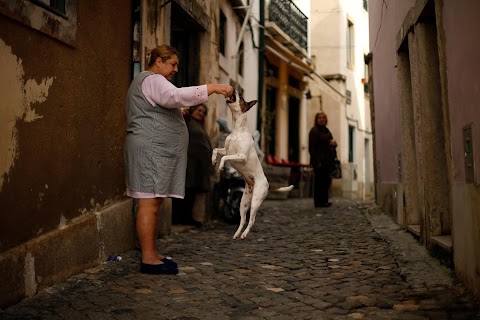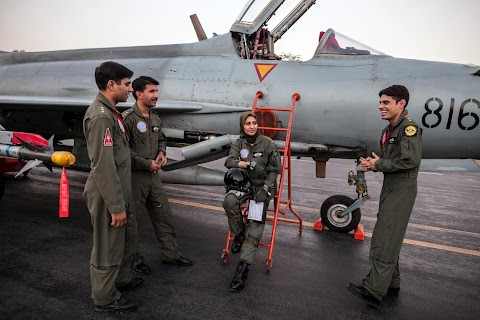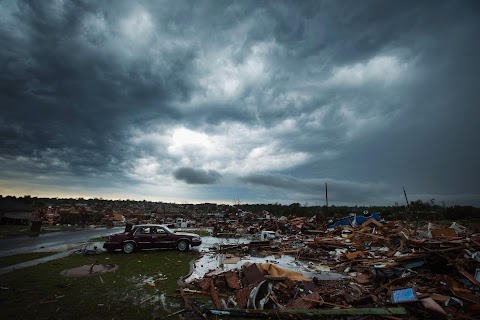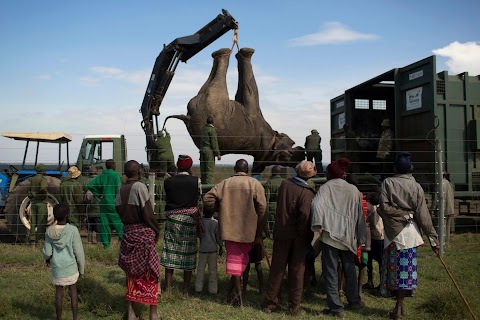
A mammoth task
 Siegfried Modola
Siegfried Modola
Locals gather around to watch as a sedated elephant is lifted into a container truck during part of an exercise to relocate 10 of the animals after they kept on straying out of central Kenya’s Ol Pejeta Conservancy and encroaching on community lands.
The move is no light matter: African elephants are the world's largest land mammals, with bulls usually weighing in at over six tonnes, according to the World Wildlife Fund.

Drowsy with sedatives, one of the elephants lies on the back of a truck as it is secured by wardens from the Kenya Wildlife Service so that it can be moved to the country’s Meru National Park.
Slideshow

A Kenya Wildlife Service (KWS) helicopter circles an elephant just after it was shot with a sedative dart.

A member of KWS veterinary staff heads towards the helicopter with a dart gun, used to target the massive animals from the air.

A male elephant wanders on the grasslands of Ol Pejeta Conservancy.

One of KWS's veterinary staff loads up a dart gun.

A staff member holds out sedatives, the effects of which usually last about three hours on elephants.

KWS wardens get ready to transport one of the males being relocated. The animals are first tied onto the back of a truck, then taken a few kilometres to a larger vehicle, which is furnished with specially designed containers to move them to Meru National Park.

A warden takes an elephant's measurements as it lies on the grass.

Locals watch as a sedated elephant is placed in a container on a truck.

KWS wardens secure an elephant so that it can be transported.

A warden holds an elephant's trunk.

One of the massive beasts is secured with ropes.

Wardens clamber around a sedated elephant on the back of a truck.
"It felt good to be in the open grasslands, teeming with animal life. This is Kenya and nature at its best."
The Kenya Wildlife Service is relocating ten elephants that keep on straying out of the Ol Pejeta Conservancy in central Kenya – a move which comes amid rising tensions with local communities, who complain that the animals keep trespassing on their properties, causing havoc to homes and crops, and endangering people’s lives.
The elephants, all males and dominant in their groups, are to be moved to Kora, in the Meru National Park, some 350km from the capital Nairobi.
This is not the first time that relocation exercises have been carried out in Kenya, either to decongest an area or simply to ease the rising tensions between humans and wildlife. It will surely not be the last time either. As the human population keeps on booming, it seems that preserving enough space for wildlife to roam freely and migrate with the seasons will always be a source of conflict.
I arrived at the Ol Pejeta Conservancy at 8a.m., after an early wake-up call and a three-hour drive from Nairobi. It felt good to be in the open grasslands, teeming with animal life. This is Kenya and nature at its best, offering a clear contrast to the bustling, traffic-congested capital that I had just left behind.
As I arrived, I made my way to the reserve headquarters where John Seren, the wildlife manager of Ol Pejeta, was waiting for me to join the relocation team. The Kenya Wildlife Service helicopter was on standby as the vet loaded a dart gun with a potent sedative. The elephants were located with the help of a light airplane, then by helicopter, from which the veterinary would shoot them with the drug.
As we sped down a dirt track in a convoy made up of land cruisers and two trucks carrying cranes to lift the giant beasts, we saw the helicopter hover above a nervous bull. He had already been shot with a sedative and now the pilot was skillfully trying to drive him into a clearing towards the place where we had stopped to witness the scene. It took the large animal several minutes to finally collapse.
The effect of the sedative on elephants lasts about three hours. However, the anti-sedative to wake them up again has to be administered as quickly as possible for the animals’ own health and safety.
The wildlife wardens worked quickly to measure, secure and lift the elephants on the back of the truck and transport them a few kilometers away, where a bigger truck was waiting with specially designed containers into which the animals had to be moved, before being transported to the Meru National Park.
It was quite a feeling to be so close and witness an exercise like this. Being able to touch an animal as majestic and beautiful as an elephant has been an experience that I will never forget.



